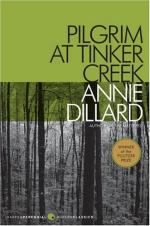
|
| Name: _________________________ | Period: ___________________ |
This test consists of 15 multiple choice questions and 5 short answer questions.
Multiple Choice Questions
1. Silvery eels swim to the sea after eight years of maturing in obscure creeks and rivers. What happens to them at the sea?
(a) they lay their eggs and then die
(b) they have offspring and bring them back in two years
(c) they mate with other eels then return to the fresh water
(d) they lay eggs and then go into deep water for the rest of their lives
2. Dillard suggests that the physical world is "all touch and go." What does she mean by this?
(a) life is uncertain
(b) things happen really fast
(c) death is easy
(d) time doesn't wait for anyone
3. What has Dillard decided is the meaning of death?
(a) it must happen or the earth could not sustain everything
(b) a journey to a far land
(c) one merely joins the earth at death
(d) a way to join the creator
4. What does the author think about fish?
(a) they are spirit food
(b) they are rather dumb water inhabitants
(c) they are quiet animals
(d) they are fairly clean food
5. In Chapter 13, Dillard is still obsessed about nature. In what way?
(a) about humans destroying nature
(b) about the beauty of an oak leaf
(c) about the rain and the sound of water
(d) against the seeming cruelty of nature
6. When do Eskimos hunt caribou?
(a) at the end of spring
(b) right before summer
(c) at the beginning of winter
(d) in the fall
7. How large might a root system for winter rye grass plant grow?
(a) a shallow system above ground spread for 15 acres
(b) one root that grows straight down for 100 yards
(c) 378 miles of roots and 6,000 miles of root hairs
(d) 65 miles of roots and 2,000 miles of root hairs
8. What is necessary in order for the the gooseneck barnacle to reproduce?
(a) it must find water of an exact salinity
(b) it must find a certain type of seaweed to cling to
(c) it must find a wrecked ship not more than one-half mile down
(d) it must find any piece of debris to cling to in the middle of the ocean
9. When a mosquito bites a snake, what happens?
(a) the mosquito lays its eggs under the scales
(b) the mosquito dies from the snake blood
(c) nothing, mosquitoes feed on snakes
(d) mosquitoes carry snake blood to other animals
10. What does Dillard say about the muskrat fur?
(a) it's thin and of little use
(b) they are the most popular fur animal in North America
(c) it tends to be spotty
(d) it's smelly when wet
11. What could happen if the caribou migrate out of the Eskimo's range?
(a) they won't get culled and will overpopulate
(b) remote Eskimo tribes can starve
(c) the polar bears will follow the herds
(d) the Eskimos won't have enough fur for coats
12. The balance enables her to think about the beauty without doing what?
(a) making all of nature bad
(b) wanting to move to a large city and never be in nature again
(c) making all of nature good
(d) constantly remember the aspects of nature which she finds ugly
13. What does Dillard believe the flood shows about nature?
(a) the effusiveness of creation
(b) it's destructive
(c) nature can't be controlled
(d) nature doesn't like humans
14. What does Dillard say is the driving force after reproduction in the animal kingdom?
(a) knowing God
(b) finding food
(c) having a nice place to live
(d) protecting the young
15. Ultimately, at the end of the book, what is Dillard's overwhelming feeling?
(a) depression
(b) anger
(c) joy
(d) puzzlement
Short Answer Questions
1. In Chapter 10, what does Dillard see as making life easier?
2. What would Dillard term passive pursuit of animals?
3. Believing natural disasters were sent by God is an example of what?
4. Eskimos believe it is a great honor to be incarnated as what?
5. Dillard says that if plants had emotions, she would applaud this:
|
This section contains 685 words (approx. 3 pages at 300 words per page) |

|




